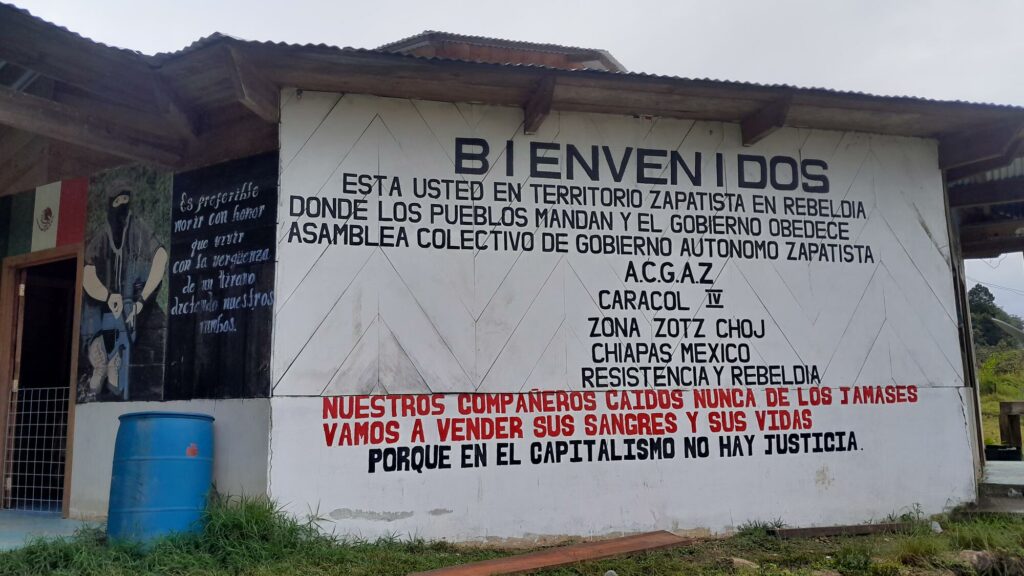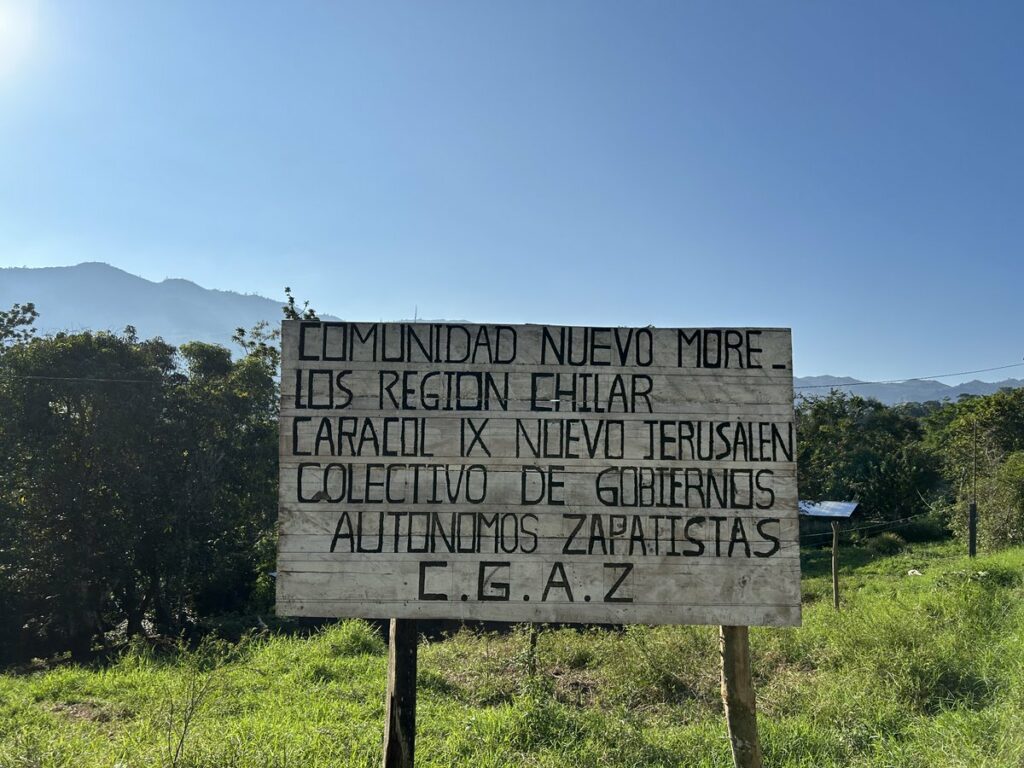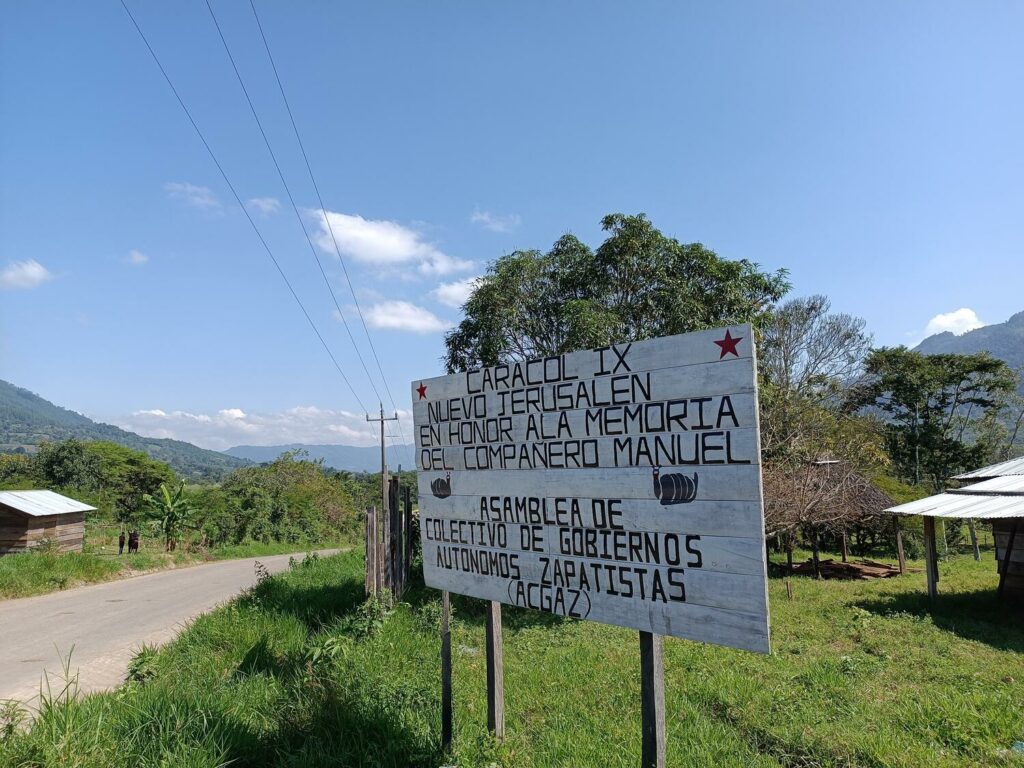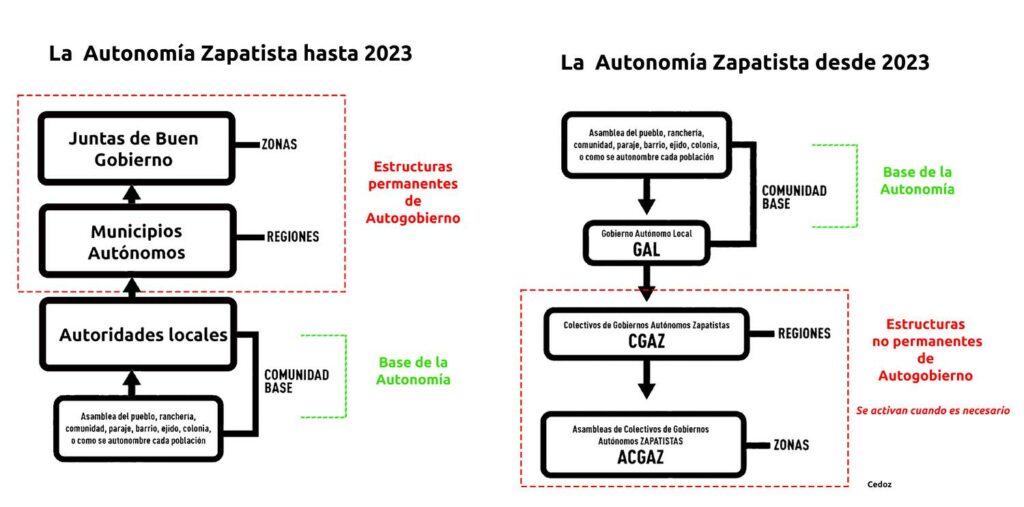
WELCOME You are in Zapatistata rebel territory, where the people govern and the government obeys.
Collective assembly of Zapatista Autonomous Governement. ACGAZ CARACOL IV Zona Zotz Choj, Chiapas, Mexico
Our fallen compañeros, never ever will we sell their blood and their lives, because in capitalism, there is no justice.
Fourth text in the series dedicated to the 30th anniversary of the uprising of the Zapatista Army of National Liberation. The author analyzes how the Zapatista movement understands Autonomy and the various organizational changes that have taken place over the course of three decades.
We can already survive the storm as the Zapatista communities that we are. But now it is not only about that, but about going through this and other storms to come, passing through the night, and arriving at that morning, 120 years from now, where a little girl begins to learn that to be free is also to be responsible for that freedom.
Third Part: Dení (11/02/23)
For that, looking at that child in the distance, we are going to make the changes and adjustments that we have been discussing and agreeing upon in common in these years, and that we have already consulted with all the Zapatista communities.
When speaking of Zapatismo, autonomy is probably one of the most followed and studied themes; they themselves opened their doors for people come to know it, fundamentally through the three Encounters of the Zapatista Peoples with the Peoples of the World and the Escuelita Zapatista. At the end of 2023, within the series of 20 Zapatista communiqués published in the context of the 30th anniversary of the uprising, they announced changes in their autonomy that implied the disappearance of two of their best known forms, the Autonomous Municipalities and the Good Government Councils; and there were those who wondered if this meant that, after so many years exercising autonomy in the context of a ferocious war against the communities, they had decided to “renounce” following this path. But no, that is not the case. What the Zapatistas are doing, after a long process of analysis, is to deepen it in a radical way. This text intends to outline an approach from their history to try to understand these changes.
Indigenous communities, both in Mexico and in the rest of the American continent, have always practiced their autonomy and self-government; it is thanks to this practice that they have survived and maintained their culture. But these practices were almost always clandestine since they were not recognized by the laws in effect in each country and this has always caused many legal problems for the peoples and those who are part of them.
It was in the years prior to 1992 and the official celebrations of the different governments that the indigenous peoples of the continent began to hold meetings, such as the Forum on the Rights of Indigenous Peoples, held in Matías Romero, Oaxaca, in 1989, or the First Latin American Meeting of Peasant and Indigenous Organizations, in October 1991, in Bogotá, Colombia, which transcended the borders of the countries in which they lived, and in which the demands for autonomy and self-government were especially heard. And by 1994, that discussion was still present.

When the Zapatista Army of National Liberation sat down for the first time, on February 20, opposite a government delegation in the Cathedral Dialogues, weeks after its Declaration of War on January 1, 1994, the right to their own government were part of their list of demands: “As the indigenous people that we are, let us be allowed to organize and govern ourselves with our own autonomy, because we no longer want to be subjected to the will of powerful nationals and foreigners” and “That justice be administered by the indigenous peoples themselves, according to their customs and traditions, without the intervention of illegitimate and corrupt governments” (points sixteenth and seventeenth).
In their sessions of dialogue, they explained that self-government and autonomy does not mean separating from Mexico. On the contrary, they want to continue being part of it, but with regard for indigenous communities that have their own reasoning, which demands respect and the establishment of a new form of relationship in which municipal authorities who do not take them into consideration or defend their interests as peoples are not imposed on them.
When this dialogue failed, the Zapatistas broke the siege of the federal army on December 19 of that same year, and created 30 Zapatista Rebel Autonomous Municipalities to begin to publicly exercise their autonomy.
The Autonomous Municipalities
Despite being declared at the end of 1994, their constitution and consolidation was put on hold, first, by the betrayal of the federal government which in February of the following year deployed the army in search of the Zapatista leaders, and then, by the hope of the possible formal recognition of autonomy through the San Andres Dialogues (1996). In the agreements signed at the first table of the dialogue, the federal government, in effect, recognized the right of the peoples to decide their internal form of government and their ways of organizing themselves politically, socially, economically and culturally, and committed itself to make the necessary changes in the Constitution. But it went no further, because later, it refused to comply with what it had signed.
In view of this, the Zapatistas decided to move forward on the road to autonomy, and the Autonomous Municipalities (MAREZ) began to formally incorporate in 1997. It was not an easy road; not only because of the active presence of paramilitary groups, supported, financed and instructed by the federal army, but also because the government unleashed a campaign against the Municipalities which, with the help of the army, the police and public security, tried to dismantle them, arresting their newly appointed authorities who populated the jails of Chiapas for many years. Among others, the operations against the Ricardo Flores Magón Autonomous Municipality, based in Taniperla, official municipality of Ocosingo, and that of Tierra y Libertad, based in Amparo Agua Tinta, municipality of Las Margaritas, are well remembered.
Even with all the repression that was exercised against them, the Zapatista Autonomous Rebel Municipalities continued to be created, and their authorities, elected by the assemblies of the towns that comprised them, began to engage in different areas of work, from commerce and transportation, to the most visible from the outside, education and health. Education and health promoters were trained, and little by little, schools were created in the communities and clinics, microclinics and casas de salud (houses of health) were built.
A second regional level of autonomous government was thus created and consolidated – the first was the local level – which, in addition, was detached from the “shadow” of the EZLN military structure, since not only did the EZLN not take part in the appointment or dismissal of authorities, but none of the military commanders or members of the Clandestine Revolutionary Indigenous Clandestine Committee could occupy positions of authority, either in the communities or in the Autonomous Municipalities.
The First Change in Autonomy
Beginning in January 2003, a series of texts were published under the name of “Mexico 2003: Another calendar, that of the resistance” which, divided into “Stelae”, shows the struggles of the country, Oaxaca, Puebla, Tlaxcala…, with Chiapas being the thirteenth stele. Published at the end of July 2003 and divided, in turn, into seven parts, it shows the profound reflection that the Zapatista communities had carried out on their autonomous organization; in it, they had found two types of problems, one, in their relationship with civil society, national and international, and another, affecting relations with Zapatista and non-Zapatista communities.
They saw that there was an imbalance in the development of the Autonomous Municipalities and their communities, which was due to the fact that the best known, those closest to the urban centers and the ones with road access, received more projects and support from civil society; also that, at times, conflicts arose between Autonomous Municipalities and between these and the official municipalities; or that the projects and community tasks were not fulfilled in the time and manner agreed upon by the communities.

So, for all these reasons, “to ensure that in Zapatista rebel territory whoever commands, commands by obeying, on August 9, 2003, the so-called “Good Government Councils” were established, one for each rebel zone, which would group together the municipalities of each one of them. Their headquarters would be in the “Caracoles.” The Zapatista Autonomous Rebel Municipalities would continue to have as their exclusive functions of government, the administration of justice, community health, education, housing, land, work, food, commerce, information and culture and local transit.
As for the Good Government Boards, their tasks were to submit reports, present work initiatives necessary for the communities, such as livestock collectives or agro-ecological training; they were also responsible for equipping the health centers in the area with the necessary equipment, such as ultrasound machines, etc. Each of the people who made up the Boards, who were elected in their communities for a period of three years and without being paid, were responsible for an area of work, but the decisions, that is, the work of government, was carried out collectively; thus, although one person coordinated health and another education, when a decision had to be made on these issues, it was taken by the entire Board.
As of August 9, 2003, the Zapatista Autonomous System was established in three levels of government:
- In each zone, the Good Government Councils, responsible authorities from the other bodies of government, although the highest authority was the villages.
- In the region, the autonomous authorities of the municipality.
- In each community, their direct authorities, agents, agents, commissaries and autonomous commissaries that constituted the basis of their autonomy from which they exercised command by obeying.
The Second Change to Autonomy
After a little more than a year of silence following the Zapatista tour of Europe in 2021 (one that was scarcely broken by some joint pronouncement with the National Indigenous Congress) in October 2023, a series of communiqués began that culminated with the announcement of important changes in the Zapatista autonomous system: the disappearance of the Zapatista Rebel Autonomous Municipalities and the Good Government Councils. This is the result of a long and profound analysis carried out in the Zapatista communities, of the achievements and failures of 30 years of living and working in autonomy, and taking a look at what was done and what could have been done but did not happen; in short, of seeing what was good and what was not.
In their analysis they saw that there were many good things that made them move forward; it was a great school in which the people were educated, in which they learned to govern themselves and acquired great experience; their education and health grew as never before, and thanks to that, they also grew.
But they also saw some things that had not worked well at all; they observed that some municipal autonomous governments and Good Government Boards were distancing themselves from the communities in such a way that the people did not properly participate, or did not present initiatives and simply waited for the Boards to do so, and if the authorities did not have much initiative, everything came to a standstill. On many occasions, the flow of information from the communities to the municipalities and Boards, and back to the communities did not work well and information was lost along the way, or the initial proposal was not transmitted in its entirety.
Their reflection led them to consider that they were building a pyramid of power just like the one built by capitalism, with great differences and improvements, it is true, but a pyramid nonetheless, with different floors on each of which were the representatives of the peoples, who sometimes made decisions for themselves, thereby distancing themselves from the communities. In short, they were copying what already existed and it was this pyramidal structure which, in itself, prevented greater participation.
The conclusion was that what capitalism was doing was no good and that other formulas had to be found so that everyone could really participate in their own government.
Another way of working, another way of searching, another way of building.
At the end of 2023 the Zapatistas announced that they were initiating a new path that would be built little by little which consisted, fundamentally, in turning the pyramid upside down, so that its base would be at the top, not at the bottom. Thus, what remains at the top are the local authorities, commissioners, and agents elected in each town or community, who form the Local Autonomous Government (GAL), that is to say, the base of autonomy. It is at this level that the necessary work, problems and their solutions are identified.
When a project or a problem involves more than one community, the Local Autonomous Governments coordinate in their region in the Collectives of Zapatista Autonomous Governments (CGAZ); and if the problem is big or affects the whole zone, then all the authorities of the zone are summoned and meet in the Assembly of Collectives of Zapatista Autonomous Governments (ACGAZ). These last two bodies are not levels of government, but of coordination and, therefore, do not have their own authorities; the only authorities are those of the Local Autonomous Governments.
Up to now, when there was a problem, it was the Good Government Board who had to think about what to do and how to solve it; now, it will be solved by the commissioners, the agents, the treasurers of each town or community, that is, the Local Autonomous Government, which can be made up of four, eight or even ten people, depending on the place. If something happens, that the school is not in good condition, that there is a lack of medicines in the clinic…, they are the first to know about it and they are the ones who act and investigate immediately. If they cannot solve the problem, they convene the village assembly and explain the problem and their actions so that the assembly can decide.
If the assembly could not make a decision, together with its authority, it calls the other authorities of the other towns that comprise the region, summoning the Collectives of Zapatista Autonomous Governments, CGAZ, of the region and if the problem still cannot be solved, the Assembly of Collectives of Zapatista Autonomous Governments of the zone is summoned and there they meet until a collective solution to the problem is found.

With the initiatives something similar happens; any of the people who live in a town, in a community, can see that there is a problem or that something could be improved; they talk, then, with the local authority, think, analyze, discuss, and then, a decision is made. And if that decision could be good for other places, they call the Zapatista Autonomous Government Collective, or the Assembly of Zapatista Autonomous Government Collectives to present the initiative to them.
Broadly speaking, this is the new path that the Zapatista peoples have initiated. The disappearance of the Autonomous Municipalities and the Good Government Councils does not mean that they have renounced their autonomy, but quite the contrary: it is a deepening of it trying to open a new path away from the capitalist schemes that, without realizing it, we assume as “natural”; the analysis they have made of their thirty years of autonomy, shows us that there are “systems” that by habit are deeply rooted in our imaginary and we think that they can be improved; what the men, women, boys and girls of the Zapatista communities have done has been to break that habit of letting ourselves go by what we know, and to imagine other horizons.
After all, this is what they have been showing us for the last 40 and 30 years, from the mountains of the Mexican southeast.
This article by Lola Sepúlveda, CEDOZ was published in El Salto on June 16th, 2024.
Translation by Schools for Chiapas.
